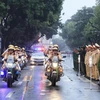Vung Tau is well known as one of southern Vietnam's most popular tourist destinations thanks to enjoy beautiful sunsets, white sand beaches and numerous water activities.
The coastal city has the perfect mix of landscapes, people and culture, including three record-holding sites.
Located at the top of Mount Nho (Small), the lighthouse was inaugurated on August 15, 1862 immediately after France occupied three southeastern provinces. It is one of the longest-standing lighthouses in Vietnam .
In 1913, the lighthouse was moved from 149m above sea level to its present elevation of about 170m.
Built in a classic old-fashioned style, the lighthouse still maintains its original features and technical components. Its round, white tower reaches 18m into the sky. Ships up to 55km out to sea can see the structure's beacon thanks to the 500W of power which lights up a huge system of prisms and triangular pieces of glass that shine though its lamp shade.
The beacon rotates at a rate of five rounds per minute. From just about everywhere along the coastal Vung Tau road, two rays of light can be seen alternately brightening the dark sky. Before electricity was brought to the structure, the light system worked thanks to a system of springs that had to be wound up every three hours.
The lighthouse is connected to the onsite residence by a solid curved tunnel. The French style, two-storey house was built at the same time as the lighthouse. A well was not practical because of the high elevation, so rain supplies the house with the water it needs year-round. A garden of su (apocyna) flower trees provides fragrant shade for the surrounding buildings.
In the last ten years, the lighthouse has proven to be a popular tourist destination, attracting numerous visitors to Vung Tau city everyday. Its magnificent architectural construction and its historical value are the main draws.
"It is a special construction in the city and Vietnam ," said Tuan Anh, an architect.
"Its French design clearly remains unchanged, although time has made its mark here in other ways. The preservation has left the lighthouse more attractive," he said.
"I have been to the city several times, but the lighthouse is still a must visit destination."
The station was built as part of the French line of defence. It was designed in a straight line at varying heights from the northwest to the southeast of Mount Lon ( Big) and Mount Nho (Small) for the purpose of creating a secure corridor for the French-ruled gateway in the southeast.
The cannon station, which is the largest in Indochina , is divided into three main areas. Twenty three cannon were built at the Cau Da Cannon Station, the Mount Lon Cannon Station and the Tao Phung Cannon Station. Cau Da has four cannon pointing towards the beach and was constructed following the shape of the mountain.
The wide view and firing range it provided was advantageous for the soldiers. The Cau Da cannon are located in a beautiful landscape which has recently begun to see gradual urban development.
Mount Lon like Cau Da, was tasked with controlling the entire gulf of Genh Rai , the gateway to Sai Gon. A system of torpedoes and gunning shelters are still here undamaged. A statue of Jesus stands at the foot of the Tao Phung Cannon Station, which was built to control the sea areas in Long Hai and Phuoc Tinh districts. The Vung Tau cannon station has the biggest collection of old guns in Indochina and is recognised as a national historical monument by the Ministry of Culture, Sports and Tourism.
The Jesus statue was built in 1974 after careful preparation of its design and model.
It is a large-scale artistic piece which melds harmoniously with the natural landscape and Vietnam 's modern architecture. It demonstrates a deep sense of religion and national character.
The 32m tall statue is the tallest in Vietnam and is said to be one of the tallest in the world.
Although the statue is made of reinforced concrete with a stone interior, it was sculpted very artistically. Jesus's face, position and clothing appear very lively and natural. The letter Tho (Longevity) from the Han Chinese script decorates Jesus's robe.
A spiral staircase climbs through the centre of the statue. A system of windows allows light to bounce off the statue's metal halo to radiate through the interior.
After climbing the 133 stairs, visitors exit onto the statue's shoulders and sleeves for a panoramic view of the city and an enjoyable sea breeze.
The statue was built on a concrete platform. The front of the platform is decorated with a relief adapted from The Last Supper by the famous Italian painter Leonardo da Vinci.
"I was really satisfied when I made it to the top of the statue, where I had a panoramic view of the surrounding area. It's so beautiful, with views of the ocean, mountains, the city centre and fishing villages," said Thuy Hang, a visitor from Hanoi .
"It's a treat after all my efforts to climb these stairs – I feel like I am at the top of the world," she added. "Standing on the statue, I also feel like I am on a ship running between a myriad of waves."/.
The coastal city has the perfect mix of landscapes, people and culture, including three record-holding sites.
Located at the top of Mount Nho (Small), the lighthouse was inaugurated on August 15, 1862 immediately after France occupied three southeastern provinces. It is one of the longest-standing lighthouses in Vietnam .
In 1913, the lighthouse was moved from 149m above sea level to its present elevation of about 170m.
Built in a classic old-fashioned style, the lighthouse still maintains its original features and technical components. Its round, white tower reaches 18m into the sky. Ships up to 55km out to sea can see the structure's beacon thanks to the 500W of power which lights up a huge system of prisms and triangular pieces of glass that shine though its lamp shade.
The beacon rotates at a rate of five rounds per minute. From just about everywhere along the coastal Vung Tau road, two rays of light can be seen alternately brightening the dark sky. Before electricity was brought to the structure, the light system worked thanks to a system of springs that had to be wound up every three hours.
The lighthouse is connected to the onsite residence by a solid curved tunnel. The French style, two-storey house was built at the same time as the lighthouse. A well was not practical because of the high elevation, so rain supplies the house with the water it needs year-round. A garden of su (apocyna) flower trees provides fragrant shade for the surrounding buildings.
In the last ten years, the lighthouse has proven to be a popular tourist destination, attracting numerous visitors to Vung Tau city everyday. Its magnificent architectural construction and its historical value are the main draws.
"It is a special construction in the city and Vietnam ," said Tuan Anh, an architect.
"Its French design clearly remains unchanged, although time has made its mark here in other ways. The preservation has left the lighthouse more attractive," he said.
"I have been to the city several times, but the lighthouse is still a must visit destination."
The station was built as part of the French line of defence. It was designed in a straight line at varying heights from the northwest to the southeast of Mount Lon ( Big) and Mount Nho (Small) for the purpose of creating a secure corridor for the French-ruled gateway in the southeast.
The cannon station, which is the largest in Indochina , is divided into three main areas. Twenty three cannon were built at the Cau Da Cannon Station, the Mount Lon Cannon Station and the Tao Phung Cannon Station. Cau Da has four cannon pointing towards the beach and was constructed following the shape of the mountain.
The wide view and firing range it provided was advantageous for the soldiers. The Cau Da cannon are located in a beautiful landscape which has recently begun to see gradual urban development.
Mount Lon like Cau Da, was tasked with controlling the entire gulf of Genh Rai , the gateway to Sai Gon. A system of torpedoes and gunning shelters are still here undamaged. A statue of Jesus stands at the foot of the Tao Phung Cannon Station, which was built to control the sea areas in Long Hai and Phuoc Tinh districts. The Vung Tau cannon station has the biggest collection of old guns in Indochina and is recognised as a national historical monument by the Ministry of Culture, Sports and Tourism.
The Jesus statue was built in 1974 after careful preparation of its design and model.
It is a large-scale artistic piece which melds harmoniously with the natural landscape and Vietnam 's modern architecture. It demonstrates a deep sense of religion and national character.
The 32m tall statue is the tallest in Vietnam and is said to be one of the tallest in the world.
Although the statue is made of reinforced concrete with a stone interior, it was sculpted very artistically. Jesus's face, position and clothing appear very lively and natural. The letter Tho (Longevity) from the Han Chinese script decorates Jesus's robe.
A spiral staircase climbs through the centre of the statue. A system of windows allows light to bounce off the statue's metal halo to radiate through the interior.
After climbing the 133 stairs, visitors exit onto the statue's shoulders and sleeves for a panoramic view of the city and an enjoyable sea breeze.
The statue was built on a concrete platform. The front of the platform is decorated with a relief adapted from The Last Supper by the famous Italian painter Leonardo da Vinci.
"I was really satisfied when I made it to the top of the statue, where I had a panoramic view of the surrounding area. It's so beautiful, with views of the ocean, mountains, the city centre and fishing villages," said Thuy Hang, a visitor from Hanoi .
"It's a treat after all my efforts to climb these stairs – I feel like I am at the top of the world," she added. "Standing on the statue, I also feel like I am on a ship running between a myriad of waves."/.



















